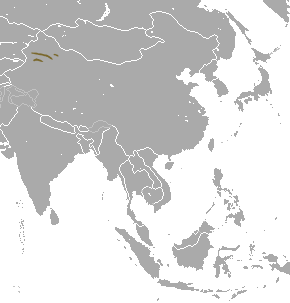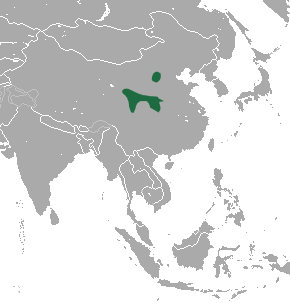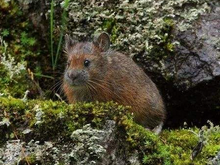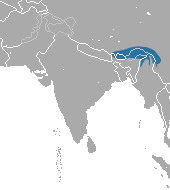
A pika is a small, mountain-dwelling mammal native to Asia and North America. With short limbs, a very round body, an even coat of fur, and no external tail, they resemble their close relative, the rabbit, but with short, rounded ears. The large-eared pika of the Himalayas and nearby mountains lives at elevations of more than 6,000 m (20,000 ft).

The Yunnan hare is a medium-sized species of mammal in the family Leporidae. It has soft, flat, and long dorsal pelage which is grayish brown or dark gray in color, and whitish ventral pelage. It was considered endemic to China, but its presence was recorded in northern Myanmar in 2000. It is a herbivore, and forages on shrubs and forbs. It is rated as a species of least concern on the IUCN Red List of Endangered Species. The Red List of China's Vertebrates has listed the Yunnan hare as near threatened, almost meeting the criteria to be listed as vulnerable.

The alpine pika is a species of small mammal in the pika family, Ochotonidae. The summer pelage of different subspecies varies drastically but, in general, it is dark or cinnamon brown, turning to grey with a yellowish tinge during the winter. The alpine pika is found in western Mongolia, eastern Kazakhstan, and Russia, as well as in China, in very cold, mountainous regions. It is a generalist herbivore, and mainly forages on mosses, tree branches, pine nuts, and plant stems. It can emit three series of different vocalizations: a long call, a short call, and an alarm call. It is rated as a species of least concern on the IUCN Red List of Endangered Species.

The Gansu pika or gray pika is a species of mammal in the pika family, Ochotonidae. It is endemic to China.

The Chinese red pika is a species of mammal in the family Ochotonidae. Typical of a pika it has short limbs, a small tail and round ears. Specific to the Chinese red pika has distinctive red color in its pelt. The Chinese pika typically lives in rocky terrain at altitudes between 600 and 1200 meters. and is endemic to the East Qinghai, West Gansu and Northern Sichuan provinces of China and Eastern Tibet.

The Gaoligong pika is a species of mammal in the family Ochotonidae. It is endemic to China. Many of the general physical characteristics of the pika species, are shared by Gaoligong pikas. However, the Gaoligong pika is specifically characterized by unique physical characteristics, including a red-brown colored crown around the neck and black behind the ears. They can produce one litter per year and can live up to three years. Their behavior is currently undetermined due to limited information available about the species. This is due to the inaccessibility of their habitat.

Glover's pika is a species of mammal in the family Ochotonidae. It was first described in 1922, by Michael Rogers Oldfield Thomas. The summer dorsal pelage is grayish rufous, grayish brown, or tea brown in colour. The winter pelage is similar to the summer pelage, but is lighter in tone. Endemic to China, it is found in high altitudes of northeastern Tibet, southwestern Qinghai, western Sichuan, and northwestern Yunnan. It is a generalist herbivore, and is known to construct haypiles. It is rated as a species of least concern by the International Union for Conservation of Nature. It is also regionally red listed as least concern in China.

The Himalayan pika is a species of small mammal in the pika family (Ochotonidae). It is found at high altitudes in remote areas of Ladakh, Uttarakhand and possibly also in Nepal &Tibet. The IUCN has listed this species as being of "least concern".

Hoffmann's pika is a species of mammal in the pika family, Ochotonidae, that is endemic to Mongolia. It is currently listed as endangered by the International Union for Conservation of Nature (IUCN).

The Ili pika is a species of mammal in the family Ochotonidae, endemic to northwest China. After its discovery in 1983, it was studied for a decade. Increased temperatures, likely from global warming, and increased grazing pressure may have caused the rapid decline in population. According to IUCN last assessed in 2018, the Ili pika is now considered an endangered species, with approximately fewer than 1,000 left.

The Ladak pika, also known as the Ladakh pika, is a species of mammal in the family Ochotonidae found in China, India, and Pakistan. Prior to identification as a separate species, specimens were thought to be of the plateau pika. Named for the Ladakh region, they are commonly found in valleys of the mountain ranges spanning from Pakistan through India to China at an elevation between 4,300 and 5,450 m and are herbivores.

The Muli pika is a species of mammal in the family Ochotonidae. The species' natural habitat is the palearctic, specifically the Yunnan Plateau subtropical evergreen forest ecoregion of the Sichuan province in China. Localized to the region’s general altitude of 3600 meters, the Muli pika is rarely encountered. The small population size and restricted habitat of the Muli pika likely threaten the species. The Muli pika is considered extant.

The Turkestani red pika is a species of mammal in the family Ochotonidae. The summer fur at its back is bright rufous and the ventral fur is white or ochraceous. The winter dorsal fur is pale brown and the ventral fur is white or light ochraceous in colour. It is found in the mountains of western Xinjiang in China, and sporadically also in the central Asian mountains in Kazakhstan, Kyrgyzstan, Tajikistan, and Uzbekistan. The female has a low fertility rate, and gives birth to offspring during the breeding season from spring to summer. She generally produces two litters each year, with two to six young. It is rated as a species of least concern on the International Union for Conservation of Nature Red List of Endangered Species, but it is considered to be near-threatened within the China part of its range.

The Moupin pika, also known as Ribetischer Pika, Moupin-Pika, Pika del Tibet, and Manipuri pika, is a species of mammal in the pika family, Ochotonidae. It has many subspecies, some of which may be distinct species. Its summer pelage is dark russet-brown with some light spots on the dorsal side, and ochraceous buff tinged on the belly. In winter it is lighter, with buff to dull brown dorsal pelage. A generalist herbivore, it is found in the mountains of the eastern Tibetan Plateau in China, Bhutan, India (Sikkim), and northern Myanmar. Both the International Union for Conservation of Nature Red List of Endangered Species and the Red List of China's Vertebrates classify it as a species of least concern; although one subspecies may be endangered.

Thomas's pika, also known as the Thomas-pika, is a species of small mammal in the pika family, Ochotonidae. The fur on its upper body is reddish brown in summer, and mouse grey in winter. It is a generalist herbivore threatened by habitat loss, being found on isolated peaks of the eastern Qilian Mountains in Qinghai, Gansu, and northwestern Sichuan, in China. The International Union for Conservation of Nature Red List of Endangered Species assessed the animal as insufficiently known in 1994, as near threatened in 1996, and as a species of least concern in 2008.

Pallas's pika, also known as the Mongolian pika, is a species of small mammals in the pika family, Ochotonidae. It is found mainly in the mountains of western Mongolia.

The black pika or silver pika is a species of mammal in the family Ochotonidae. It was thought to be common to the Yunnan Province of China where it was first discovered in 2000, it is only known from four specimens. The validity of the species has been questioned, with some studies suggesting that the known specimens represent melanistic individuals of Forrest's pika.

The Tsing-ling pika is a species of pika endemic to the mountains in Central China. It inhabits mountainous forests and shrublands. It is a poorly known species.




















